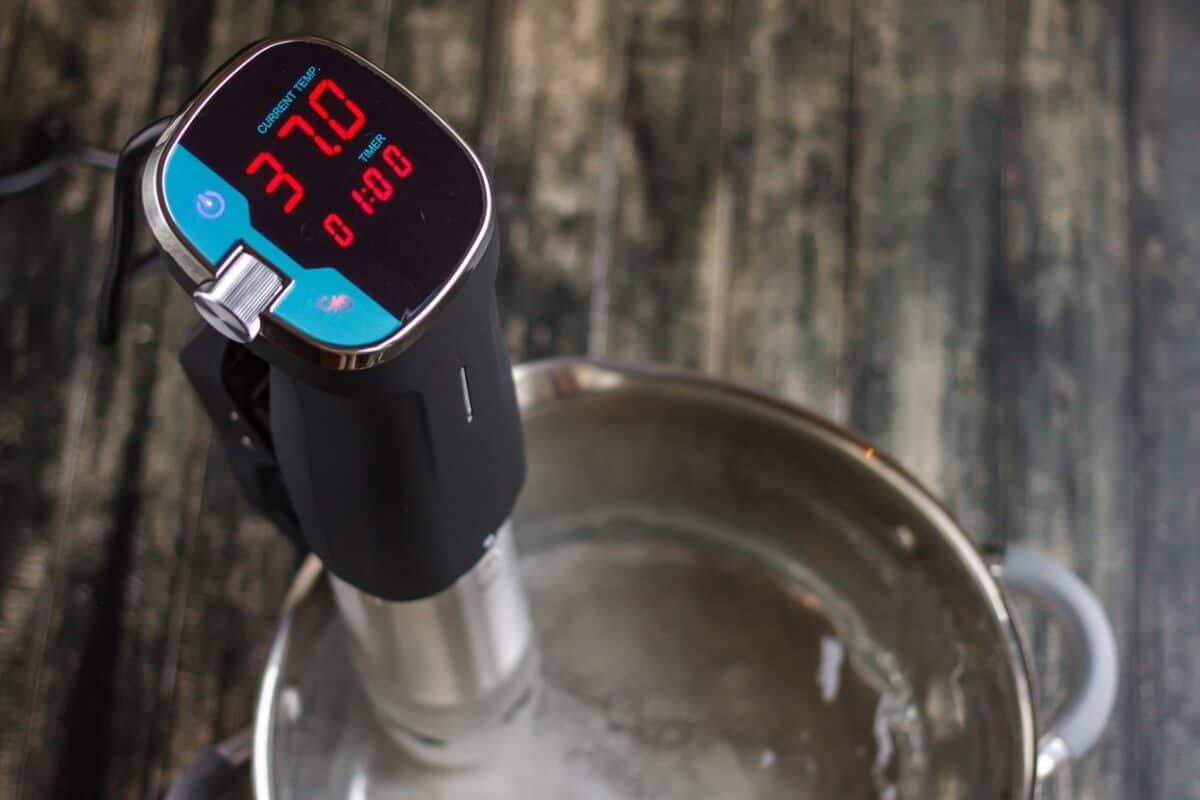Last Updated on 22nd December 2021 by
When it comes to tempering chocolate, there are many ways to get the job done. You can try the classic stovetop or microwave method, but if you want extra precision from the comfort of your own kitchen, then the sous vide cooker method should be right up your alley.
In this article, we’re sharing a complete guide on how to use sous vide to temper chocolate at home.
What is Chocolate Tempering?
Chocolate contains cocoa butter, also known as cocoa fat, which is the main ingredient in chocolate that gives it its solid texture. Cocoa butter consists of crystals that vary in form from loose and unstable to well-structured and firm.
The structure of the stable crystals breaks down when you melt chocolate, and if you let it set to solidify, the chocolate will harden in a longer time. Not only will this cause the chocolate to lose its shine, but it’ll also develop a softer texture where the chocolate will melt to touch.
There are 6 different crystals into which chocolate can solidify. The stable crystal structure (also referred to as beta crystals) is the one with the highest melting point.
This is where tempering or pre-crystallization comes in; it’s a method of chocolate melting that enables the formation of beta crystals. Once you have enough beta crystals, you’ll be blessed with snappy, shiny, and hard to melt chocolate.
Can you Temper Chocolate in a Sous Vide?
Yes, you can. In fact, tempering chocolate in a sous vide is the best way to get the job done. Tempering chocolate requires precise temperature control, and well, a sous-vide circulator or cooker is designed exactly for this purpose.
Additionally, the sous vide method is practically 100% foolproof and can be done with any amount of chocolate you want. It’s also virtually mess-free and the produced chocolate is easy to re-store for later use with almost no waste.
The only drawback to this method is that you need to buy a sous vide circulator. Not everyone is ready to afford such an investment.
Chocolate Tempering Temperatures
The tempering process involves cooking the chocolate across 3 different temperatures to form enough stable beta crystals so you can start working with the melted chocolate.
The following temperatures apply directly to dark chocolate. Milk chocolate should be 3.5°F lower while white chocolate should be 7°F lower respectively.
- The first stage (heating): 122°F / 50°C.
- The second stage (cooling): After 15 minutes, lower the temperature to 82°F / 28°C.
- The third stage (reheating): After 15 minutes, raise the temperature to 90°F / 32°C and cook for another 10 minutes.
How to Use Sous Vide to Temper Chocolate
Instructions
- Vacuum seal the desired amount of chocolate into a bag using a hand pump or, ideally, a vacuum packer.- It’s okay if the bag isn’t too tight since the chocolate will change shape once melted anyway.- You can do several bags together as long as you have a water bath that’s big enough.
- Once the temperature of the water reaches 122°F / 50°C, place the sealed chocolate bag in the water. Make sure the bag is fully submerged.
- You’ll notice the chocolate melting quickly, and once that happens, you need to lower the temperature to 82°F / 28°C by adding ice cubes or cold water. You can also change the water.
- While the chocolate is cooling (about 15 minutes), take out the bag and rub it to ensure that all the chocolate is cooling as one. Repeat this a couple of times over the following 5 mins. After the 5 minutes, the chocolate should’ve cooled down sufficiently.
- Now, turn the water bath heater back on and get the temps back up to 90°F / 32°C.
- Continue to occasionally rub the bag to make sure all the chocolate comes together as one.
- Another 5 to 10 minutes should be enough for this final temperature change.
- Once you’re ready to pipe your chocolate, you can just cut off the corner of the bag and get to action if you’re using disposable bags. If not, scoop the chocolate out of the bag and transfer it into a piping bag.
- Twist and squeeze the bag at the back to make it tight enough to create pressure so you can push the chocolate out the nozzle end.
- Work with the chocolate.
Things to Avoid When Tempering Chocolate
Although tempering chocolate in a sous vide cooker is a pretty simple process, there are some things you should avoid. Otherwise, you may end up ruining the whole batch of chocolate beyond saving.
1. Water
Water is one ingredient that you should keep away from your chocolate while tempering. Chocolate doesn’t contain water, and that should tell you how much chocolate hates water.
Even if it’s just a single drop of water that fell into the bowl of melted chocolate, it can still destroy its consistency. When that drop falls in, it’ll quickly break down the crystal structure of all the chocolate in the bowl, resulting in a grainy mess that no one can salvage.
2. Overheating
Overheating happens when you heat chocolate up to 145°F / 62°C or higher. Pastry chefs and confectioners refer to this as chocolate “burning” although no burning actually happens.
Instead, the chocolate breaks down and transforms into an unrecoverable state.
Similar to the water situation, you’ll need to start over with a fresh batch of chocolate if the one you’re working with reaches this stage.
3. Overcooling
Another thing you should look out for is overcooling. If you accidentally drop the temperature below 82°F during the cooling phase, you’ll end up producing too many Form III or lower crystals.
Such crystals can prevent the formation of stable Form V crystals later on when you reheat the chocolate. Unlike previous cases though, you can fix this by reheating the chocolate up to 115°F and starting over.
Wrap Up
There you have it, everything you need to know about tempering chocolate at home using a sous vide cooker.
I'm Pauline, a mother of four grown children, my passion for cooking stemmed from the joy i get cooking for my family. I love to try new dishes, especially when dining out but creating and sharing my own recipes is my favourite thing to do!


